

Anthony Weber interview
By Scott Stilphen
(2004)
Ask any Atari 8-bit computer user about STEDEK games, and chances are they will remember seeing or playing one of their “unofficial” arcade ports. What you may not know is that not only are they still around, they did an update to one of their games in 2002 - Star Island! I had a chance to talk with the founder of STEDEK Software and former Roklan programmer, Anthony Weber, about this and other worthy topics.
Q: From your website, you mention you earned your B.S. in Physics from the University of Detroit Mercy. How does a Physics graduate end up doing game programming?
Anthony Weber: I started working at Ford as a process engineer. A couple of years later, I found myself working on a task force with some engineers who would occasionally enter data at an ASR33??? Curiosity got the best of me and I started to work at it (with borrowed user id/password) and eventually got hooked. I later transferred to the Exhaust Emissions Testing group because I had a bit of computer programming background and could liaison with the computer folks developing emissions testing equipment. As the story goes, I got deeper and deeper into programming, loved its challenge, and got completely immersed in computers when I got my Atari.
Q: How did the formation of STEDEK come about? Is there any meaning to the name?
Anthony Weber: Actually, my wife suggested the name as I was reverse-engineering Atari's Space Invaders game into what became my first game, Laser Strike. It stands for Steve, Tom, Eric, David, Elizabeth, and Kristina, our six kids.
 Q: Galactic Chase,
Laser Strike, and Star Island are all obviously based on popular coin-op games at the time (Galaxian, Space Invaders, and Star Castle respectively), and equally popular among Atari owners (especially Star Island – it’s considered by many to be the best home version of Star Castle for ANY system!). Did any copyright problems arise as a result of doing these “unofficial” ports?
Q: Galactic Chase,
Laser Strike, and Star Island are all obviously based on popular coin-op games at the time (Galaxian, Space Invaders, and Star Castle respectively), and equally popular among Atari owners (especially Star Island – it’s considered by many to be the best home version of Star Castle for ANY system!). Did any copyright problems arise as a result of doing these “unofficial” ports?
Anthony Weber: Yes and no. I'm really surprised that Laser Strike was ever noticed, given that only 10 copies of the cassette ever made it to the public (through a computer store in Clawson, MI). One of the store's sales people told me that Atari said they couldn't sell the game. So, after the 10 cassettes, that was it. It also made me very concerned about Atari when I finished Galactic Chase and sold it through another local computer store. However, I never received any feedback from Atari about Galactic Chase, even though they had obtained the rights to the home version from either Namco or Midway. Nobody ever approached me about Star Island.
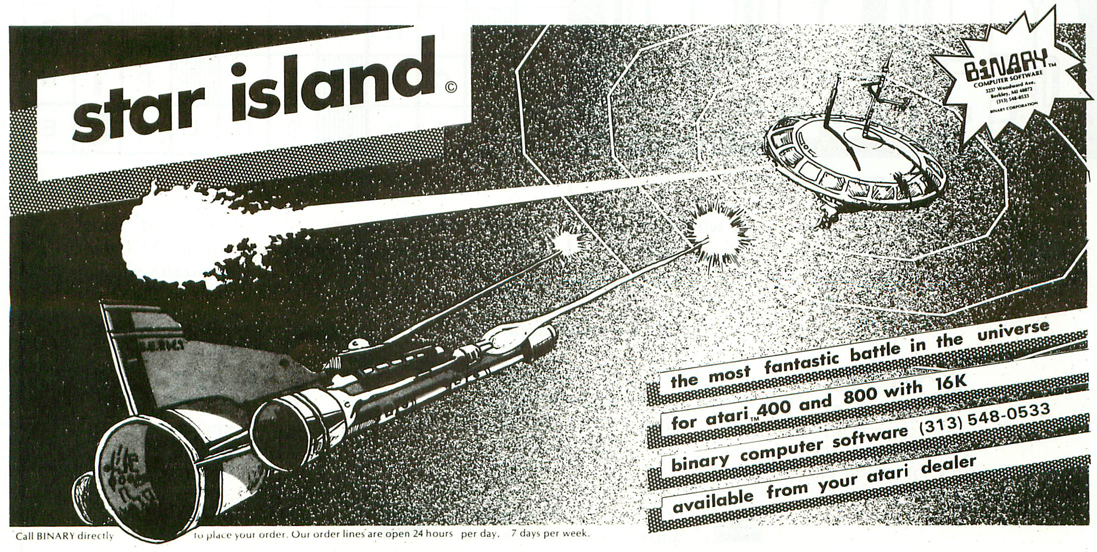
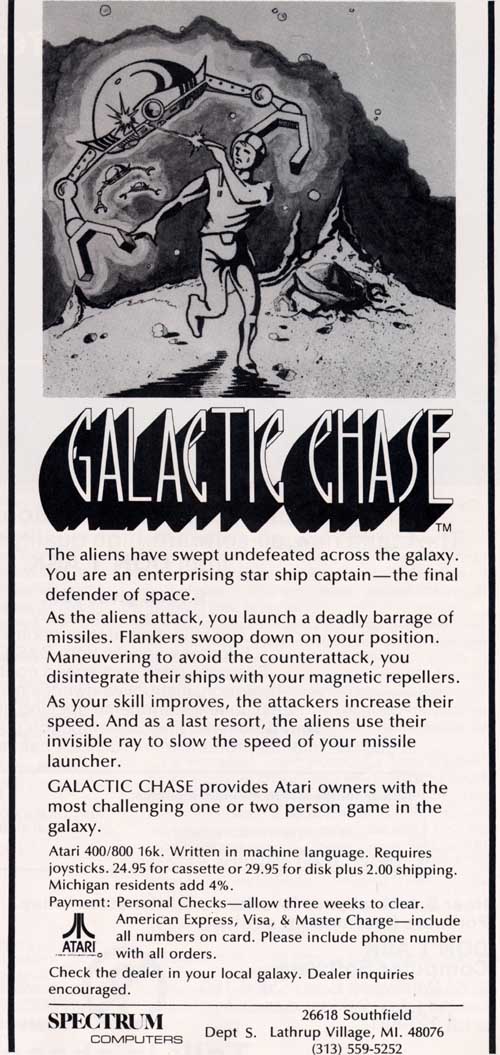
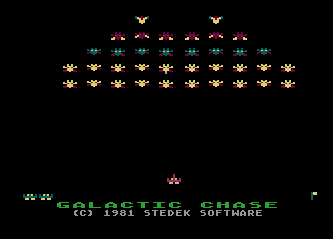
Q: I noticed a small similarity between Galactic Chase and Star Island – the cannon in S.I. and the flag ships in G.C. are the same (graphics)! Was this done out of convenience, or just a little personal “trademark” of sorts?
Anthony Weber:The flag ship graphic was something that I added to connect Galactic Chase to Star Island. It took me almost seven months of nights and weekends to develop S.I., and only about three for G.C., even with the false start of trying graphics for the aliens rather than modified character sets.
Q: What made you decide to do only Atari 400/800 ports? Did you consider doing them for any other system(s)?
Anthony Weber: It's strange sometimes how things turn out. The Atari 800 was my first computer. I finally decided to get it after seeing their Breakout and Star Raider games. I was both pleased and disappointed at their rendition of Space Invaders, and that's what prompted me to teach myself 6502 Assembler and pull Atari's game apart.
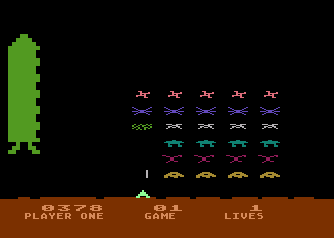

Atari’s 400/800 Space Invaders (left) and STEDEK’s Laser Strike (right)
Q: Isn’t Laser Strike more of a modification to Atari’s own Space Invaders version?
Anthony Weber: Exactly. I bought a 6502 disassembler tool and adapted it so that I could read Space Invaders from the cassette. As I mentioned above, I liked the barriers in the original, and decided to see if I could put them into Atari's version. Later, I sent a note to Atari asking them to consider my version, but they replied that not only were they not interested, but also that I couldn't sell my version... after that, I never did.
 Q: That’s ironic, since they later released their own modified version (with
bunkers) for their 5200 game system!
Q: That’s ironic, since they later released their own modified version (with
bunkers) for their 5200 game system!
Anthony Weber: I agree, at least to the irony. However, I was trying to sell a reverse-engineered version of their original game. Also, I wasn't even aware that they ever released a modified version for any of their systems.
Q: Were those the only 3 titles you did under the STEDEK name? Were they ever re-released by Roklan?
Anthony Weber: Those were the only ones. I joined Roklan to manage one of their Atari groups, and to also develop games for them. After joining, they considered re-releasing my games, but they never did follow through to my knowledge. I never found out what “Roklan” stood for…
Q: Do you recall who hired you, or any of the other programmers there?
Anthony Weber: The only folks I can remember at this point are Jim Gonzales (one of two VPs), Ron Borta (the VP who actually hired me), Joe Hellesen, and Joe Wagner (my counterparts and Atari Managers). Roklan worked on the Atari 2600, 5200, 400/800, C-64, VIC 20, Color Computer, and the TI.
Q: I know that Roklan released a port of Deluxe Space Invaders, called Deluxe Invaders. Besides having the same reddish ground, it also seems to use some of the same sound effects (as the Atari version), but it doesn't appear to be a modified version of the same game. Maybe since they already have a Space Invaders game in their catalog, that’s why they decided not to at least release your Laser Strike?
Anthony Weber: I believe that Deluxe Invaders was released before I arrived at Roklan. I really don't know whether they started with Atari's version like I did or did it from scratch. For them to release any of my games, I would have had to get out of distribution agreements I had with two local computer stores. I don't believe they wanted to even get involved. They were also showing early signs of imploding - late paychecks, etc.
As it turned out, I would have been better off distributing Star Island myself, as I only ever got paid for about 100 copies. Yikes.
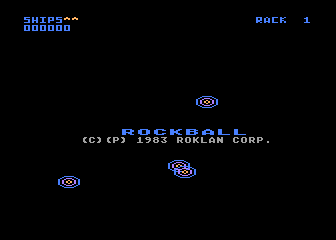
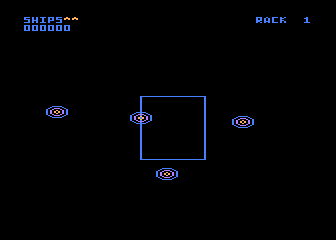

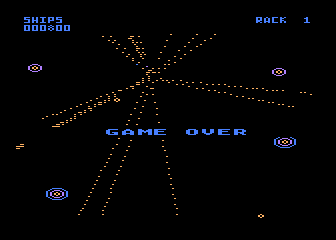
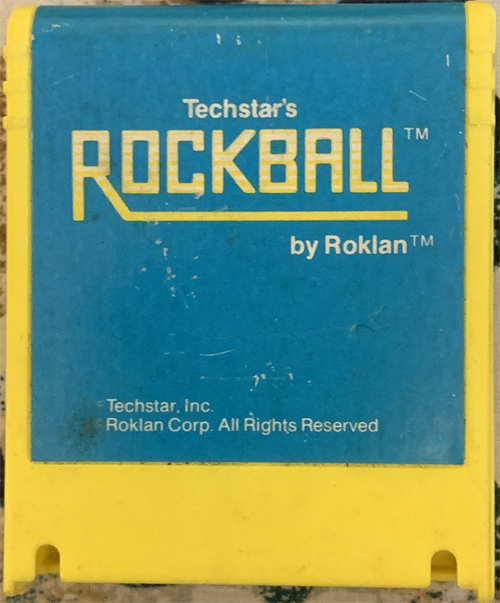
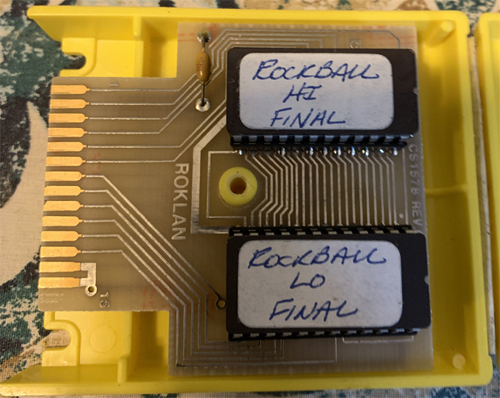
Rockball prototype, dated 4-23-83, discovered in June 2015 (website).
Q: You also did at least 2 Roklan titles that I know of that never were published- one being Rockball. It was mentioned in the August/September issue of Video Games Player (pg. 24). Christian Scott posted this comment of yours (?) regarding it:
"The one that I worked on for the Atari never got released... Rockball, a clone of an arcade game by the same name."
Anthony Weber: Yes, Rockball was an arcade game variant of Asteroids. The concept of big rocks (that were really small sets of concentric rings), and a spaceship that could blast them into smaller rocks was essentially identical to Asteroids. The player's ship received energy by destroying the rocks, which split apart into smaller rocks, each time hit by a player's missile. Where it differed was in the startup, which created a rectangle in the center of the screen, which disappeared at the same time the ship appeared, but only if no 'rocks' were within the rectangle. The twist in the game was a gravity force would randomly appear in the middle of the screen and teleport the player. If unlucky enough to get sucked into it, it would drop the ship somewhere else on the screen, possibly on top of or in the path of one of the rocks. Another variation was the box that appeared around a new ship until no rocks were within. It played really well, but was never officially released that I know of.
It was the first game I did for Roklan. The internals of the arcade game (i.e., screen, platform, joystick, etc.) were shipped to me while I was still in Michigan. I finished it before we physically moved to Chicago.
Q: Do you recall who made the arcade game? I can't find any information about it on any of the major arcade database sites...
Anthony Weber: I don't remember who actually made the game, but discovered a possibility - Techstar - who apparently hold the trademark to an arcade game called "Rockball", circa 1982, about the right time, since I worked on Roklan's version the spring of 1983.
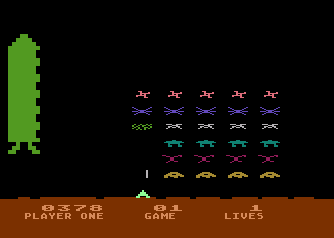

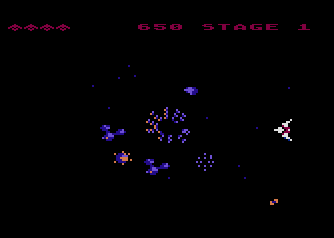
Anthony Weber’s version, as shown on the Parker Brothers box (LEFT) and
prototype (CENTER), compared to the actual released version
by Joe Hellesen (RIGHT)
Q: That must be it. The other game listed there, Eyes, was manufactured by Rock-Ola and the game shows the credit "Copyright 1982 Digitrex Techstar". Digitrex Techstar was based in Miami, Fl and founded by former Centuri VP Bill Olliges. The other released title of yours that I know of is Gyruss. Since Parker Brothers ended up releasing Gyruss for a number of different systems, I’m guessing that your version precedes theirs. Is this correct? Why weren’t either of these ever released?
Anthony Weber: I worked on the Atari version of Gyruss just before Roklan folded. I was about two weeks from finishing it when I had what would best be described as a 'falling out' with Parker Brothers (they decided not to honor a verbal agreement we had). Although the game shots on the box were from my version, the game that Parker Brothers actually released was not (Ed.: They are very similar, but not exactly the same link). I never did find out who did their released version (Ed.: Joe Hellensen did the released version link).
Like the other games I did, it never got released into production. I believe that I've got a copy of the floppy somewhere buried in a box in our garage, but have so far not been able to find it. One of these days I'm going to go back through the entire set of boxes... (Ed. Anthony never got around to finding the game. I contacted him in 2011 about it and he replied, "As regards my copies, I still haven't had a chance to look for them (I'm currently in Alabama working for a company using IBM's Rhapsody for systems and software engineering projects) and get back to the house in Illinois infrequently. One of these days...". Not long after that, there was a fire at his house and presumably anything he still had was lost.)
Q: How was Parker Brothers able to advertise their game using a screen shot of your version? Did you or Roklan ever consider filing legal action against them for this? And why would they even bother to have it reprogrammed, instead of just paying for yours?
Anthony Weber: Remember that their arrangement was with Roklan, and not simply with me. The agreement that we arrived at over the phone just before I left Roklan was to finish up the Roklan game. So, I expected that they had rights to both the one that I was nearly done with and the one that was actually released. I have to say that while the game wasn't as smooth as mine, all of the game elements were there, whereas I compromised some of the shapes (on the bonus screens, for example) for play and detail. Whoever did the version that Parker released did manage to get everything in.
Q: Were there any other games that you worked on but never finished? Any ideas that you wanted to implement with any of your released games but couldn’t (due to time or memory restrictions)?
Anthony Weber: No. I really found the challenge in adapting the arcade games to home versions. Galactic Chase's aliens were actually remapped character sets, and not drawn pixels per se. One severe limitation in those days was the fact that so many objects had to be moved smoothly, and the 6502b, which was clocked faster than the Apple's at that time, was still slow to deal with. The lines in Star Island were actually not lines drawn at all, but a continually mapped data table plotted to look like lines. The line draw routines were very slow, and drawing and redrawing lines was very costly. A bit of self-modifying code later, and I had my "lines". It was really neat what you could do in assembler if you didn't have to worry about someone ever needing to work with your code.
Q: Do you recall any “Easter eggs” or hidden tricks/messages in any games that either you worked on, or games by others?
Anthony Weber: No. However, in Rockball, which was to be released on ROM, I did put in several booby traps for those who might port the game to RAM.
Q: That sounds like a clever anti-piracy/software protection scheme.
Anthony Weber: Actually, it was fairly simple. In one unrelated part of the program, I'd insert an instruction that would change the op-code of another area of the program, such as a change from BNE (branch 'if not equal to zero') to a BPL (branch 'if plus -' this branches also if zero). This is pretty subtle, but would cause the game to hang in a way that I hoped would not be easily found (line-to-line searches would eventually find the extraneous instruction).
Q: Is that what we would consider self-modifying code today?
Anthony Weber: That's one example. However, I was relying on the fact here that the code wouldn't be modified. In my new Star Island game, which was RAM-based, I actually changed op-codes on the fly. Scary stuff. That's another example of self-modifying code.
Q: What was it like working for Roklan? Are there any anecdotes or stories that you recall from those days?
Anthony Weber: Frenetic. The challenge was incredible. Gyruss was perhaps my biggest challenge, and I ended up working 7 days a week, 12 hours a day in order to finish it. The best part of that process was probably that our kids got to play the arcade version over and over (it was sitting in my home office, while they played and I shot videos of the action).
Before we moved from Detroit to Chicago, I worked on Rockball, and had it in my home office there. During my development of the Atari version, I encountered a 'bug' that was destroying a part of the player's score. It involved the player's ship exploding near the score; at the end of the explosion, pieces of the score would disappear. I later traced the problem through stop-action (freeze-frame) video recordings to the fact that the explosion traces that hit the border would stop tracing their paths, but would later be cleared regardless of where they were. The ones that had hit the border were the ones causing the corruption. It was because of this that I was able to justify the video equipment's purchase for my work on my tax return.
Q: I don't recall any other programmers using this unique method of trouble-shooting. Was that something you saw someone else doing, or your own idea? Was this just an alternate method in place of using a monitor program?
Anthony Weber: Actually it was pretty much a last resort. Video cameras were relatively new in 1983, and I finally considered filming the game after not being able to pinpoint the problem. I didn't have a monitor and didn't want to go to the trouble of adding one, so this seemed like a likely alternative. I was literally able to single-frame step through the explosion and almost immediately realized what was happening when I got to the explosion's end.
Q: Do you remember any other troublesome bugs or glitches during development of any of your games, or any that were discovered after they were released?
Anthony Weber: If a player lost their last ship while firing a missile during Galactic Chase, the sound of the missile fire stayed on. That's the only bug I ever got feedback on after its release.
Q: You worked at Roklan for about a year, correct? Did the market “crash” precipitate your leaving there?
Anthony Weber: Had Roklan been able to survive, I probably would have stayed. I really enjoyed working there.
Q: How did you get into programming for the Commodore 64? Was it easier to program for that or the Atari?
Anthony Weber: After Roklan folded, I joined a company (Micro-Technology Development Corp.) for a short time managing games development, which now included the Color Computer, and the C-64. I worked on a couple of children's games for the C-64, but don't remember their names. Granted, this is really solely my opinion, but the OS of the C-64 was not very well organized, and the video layout, while allowing better sprite control, was split into two distinct areas. I really liked the Atari's layout better.
I also worked on a couple of Atari programs for Disney that I helped finish after leaving Roklan - Peter Pan's Cove and Peter Pan's Perilous Passage. However, it's entirely possible that others were developing them for the C-64 or the Color Computer.
Q: Why did you ultimately decide to leave the game industry?
Anthony Weber: Economics. When Roklan folded, I was a person with self-taught experience in an industry that was quickly imploding in a city with no real automotive industry. I was lucky in landing a consulting job with Ford and commuted weekly back-and-forth to Detroit for several months until a job in Chicago appeared. Eventually, I found a place in real-time embedded systems development work and have been there ever since. It's kind of like video games, only on serious stuff. I'm currently working for a company using IBM's Rhapsody for systems and software engineering projects.
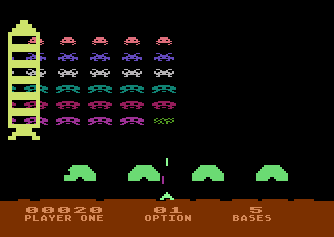
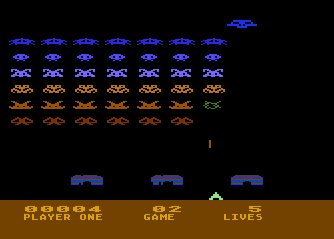
Anthony Weber’s
latest PC version of Star Island.
Q: On your website, you mentioned doing a recent PC version of Star Island. How did this come about? And is it available?
Anthony Weber: I really didn't consider adapting my Atari versions to anything else until two years ago, when I decided to redesign my Star Island game for the PC. It's available to anyone who would like a copy. I never designed it to sell; I'd have to coordinate with Telelogic if I did. Rather, it was an experiment to test the rigor of structured development using the real-time development tool (Telelogic's Tau) that Telelogic, the company I was working for at the time, had developed.
Q: You have quite an impressive resume! Besides the recent Star Island game/demo update you did, have (or had) you ever thought of returning to game design since Roklan?
Anthony Weber: Not really. I have different challenges now, consulting in an area of systems development that I can really contribute to. I've said many times that I'm a hacker by trade (yes, I really did break into a computer while at Ford, but it was for a really good reason - to shore up security for our emissions data). Systems development has become really structured, and modeling software with automated tools is as big a challenge as I've ever had.
Q: What are some of your personal favorite games (for any platform)? Or which title(s) were the most influential in your decision to start programming?
Anthony Weber: Space Invaders was really the first game that drew me toward the business. I remember going up to the local bowling alley after the kids were asleep to play Space Invaders and later Galaxian. However, Pac-Man was really my favorite.
Q: What are your thoughts on the current state of gaming?
Anthony Weber: That's one of the reasons why I haven't gotten back into the industry. The new games are really impressive, and take teams of people to develop. I'm really doing similar stuff with the teams of people I help, so I'm getting my challenge, just in a similar environment.
As an added bonus, Anthony has allowed me to distribute his PC version of Star Island for free!
To learn more about Anthony's work, visit his website, at: www.stedeksoftware.com
| GAME | SYSTEM | COMPANY | STATUS |
| Laser Strike | Atari 400/800 | STEDEK Software | released |
| Galactic Chase | Atari 400/800 | Spectrum Computers (STEDEK Software) | released |
| Star Island | Atari 400/800 | Binary Computer Software (STEDEK Software) | released |
| Rockball | Atari 400/800 | Roklan | unreleased |
| Gyruss | Atari 400/800 | Roklan | unreleased |
| "several children's titles" | C-64 | Micro-Technology Development Corp. | |
| Peter Pan's Cove | Atari 400/800 | Disney | unknown |
| Peter Pan's Perilous Passage | Atari 400/800 | Disney | unknown |
| Star Island | PC | independent | released |